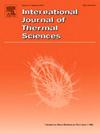Numerical study on the flow and heat transfer in a novel fractal gradient porous material (FGPM)
IF 4.9
2区 工程技术
Q1 ENGINEERING, MECHANICAL
International Journal of Thermal Sciences
Pub Date : 2025-05-17
DOI:10.1016/j.ijthermalsci.2025.110001
引用次数: 0
Abstract
The gradient porous material (GPM) has been widely applied in enhanced heat transfer applications due to its flexibly designable structure, higher thermal conductivity and better stability. Therefore, a rectangular heat sink is designed by using a fractal gradient porous material (FPGM) based on the bionic principle in order to improve its thermal performance. Four porosity gradient-increasing and four porosity gradient-decreasing configurations with the same pore size and average porosity are proposed. And the flow and heat transfer properties of the FGPM are numerically studied by using the Forchheimer-Brinkman extended Darcy equation and local thermal equilibrium model, which has been validated by comparing with experimental data. The results indicate that the FGPM with decreasing porosity gradient along the flow direction has better performance compared with that of uniform porous material (UPM) and porosity gradient-increasing FGPM. A maximum comprehensive performance improvement of 0.7 % is achieved by the FGPM with decreasing porosity gradient at Reynolds number of 730. And it allows for a flexible structural design tailored to different temperature regions within various heat sink systems. The present results provide useful guidelines for enhancing heat transfer performance and improving temperature uniformity of heat sinks.
新型分形梯度多孔材料(FGPM)内部流动与传热的数值研究
梯度多孔材料(GPM)以其结构设计灵活、导热系数高、稳定性好等优点在强化传热领域得到了广泛应用。为此,基于仿生原理,采用分形梯度多孔材料(FPGM)设计了矩形散热器,以提高其散热性能。在相同的孔径和平均孔隙度条件下,提出了4种孔隙度梯度增大和4种孔隙度梯度减小的构型。采用Forchheimer-Brinkman扩展达西方程和局部热平衡模型对FGPM的流动和传热特性进行了数值研究,并与实验数据进行了对比验证。结果表明,沿流动方向孔隙度梯度减小的FGPM比均匀多孔材料(UPM)和孔隙度梯度增大的FGPM具有更好的性能。当雷诺数为730时,随着孔隙度梯度的减小,FGPM的综合性能提高了0.7%。它允许灵活的结构设计,以适应不同温度区域的各种散热器系统。本文的研究结果为提高散热器的传热性能和温度均匀性提供了有益的指导。
本文章由计算机程序翻译,如有差异,请以英文原文为准。
求助全文
约1分钟内获得全文
求助全文
来源期刊

International Journal of Thermal Sciences
工程技术-工程:机械
CiteScore
8.10
自引率
11.10%
发文量
531
审稿时长
55 days
期刊介绍:
The International Journal of Thermal Sciences is a journal devoted to the publication of fundamental studies on the physics of transfer processes in general, with an emphasis on thermal aspects and also applied research on various processes, energy systems and the environment. Articles are published in English and French, and are subject to peer review.
The fundamental subjects considered within the scope of the journal are:
* Heat and relevant mass transfer at all scales (nano, micro and macro) and in all types of material (heterogeneous, composites, biological,...) and fluid flow
* Forced, natural or mixed convection in reactive or non-reactive media
* Single or multi–phase fluid flow with or without phase change
* Near–and far–field radiative heat transfer
* Combined modes of heat transfer in complex systems (for example, plasmas, biological, geological,...)
* Multiscale modelling
The applied research topics include:
* Heat exchangers, heat pipes, cooling processes
* Transport phenomena taking place in industrial processes (chemical, food and agricultural, metallurgical, space and aeronautical, automobile industries)
* Nano–and micro–technology for energy, space, biosystems and devices
* Heat transport analysis in advanced systems
* Impact of energy–related processes on environment, and emerging energy systems
The study of thermophysical properties of materials and fluids, thermal measurement techniques, inverse methods, and the developments of experimental methods are within the scope of the International Journal of Thermal Sciences which also covers the modelling, and numerical methods applied to thermal transfer.
 求助内容:
求助内容: 应助结果提醒方式:
应助结果提醒方式:


